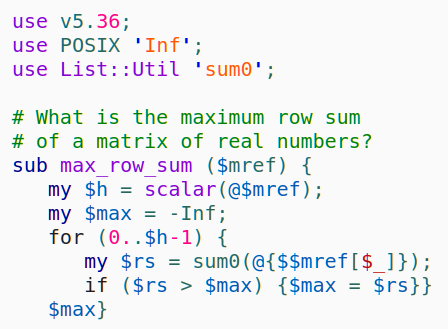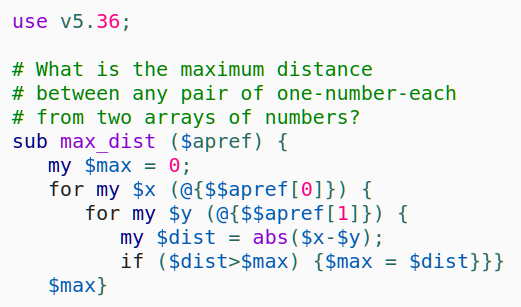Robbie Hatley's Solutions, in Perl, for The Weekly Challenge #338 (Theme: “Mad Max Beyond Perldome”)
For those not familiar with "The Weekly Challenge", it is a weekly programming puzzle with two parts, with a new pair of tasks each Monday. You can find it here:
The Weekly Challenge for the week of 2025-09-08 through 2025-09-14 is #338
The tasks for challenge #338 are as follows:
~~~~~~~~~~~~~~~~~~~~~~~~~~~~~~~~~~~~~~~~~~~~~~~~~~~~~~~~~~~~~~~~~ Task 338-1: Highest Row Submitted by: Mohammad Sajid Anwar You are given a m x n matrix of real numbers. Write a script to find the highest row sum in the given matrix. ( # Example #1 input: [ [4, 4, 4, 4], [10, 0, 0, 0], [2, 2, 2, 9] ], # Expected output: 16 # Example #2 input: [ [1, 5], [7, 3], [3, 5] ], # Expected output: 10 # Example #3 input: [ [1, 2, 3], [3, 2, 1] ], # Expected output: 6 # Example #4 input: [ [2, 8, 7], [7, 1, 3], [1, 9, 5] ], # Expected output: 17 # Example #5 input: [ [10, 20, 30], [5, 5, 5], [0, 100, 0], [25, 25, 25] ], # Expected output: 100 );
I'll start by setting a "$max" variable to POSIX "-Inf", then I'll use "sum0" from List::Util to sum each row, and if any row sum is greater than $max I'll set $max to that sum. I'll then return $max.

Robbie Hatley's Perl Solution to The Weekly Challenge 338-1
~~~~~~~~~~~~~~~~~~~~~~~~~~~~~~~~~~~~~~~~~~~~~~~~~~~~~~~~~~~~~~~~~ Task 338-2: Max Distance Submitted by: Mohammad Sajid Anwar You are given two arrays of real numbers. Write a script to find the maximum distance between any pair of values from both arrays. ( # Example #1 input: [[4, 5, 7], [9, 1, 3, 4]], # Expected output: 6 # Example #2 input: [[2, 3, 5, 4], [3, 2, 5, 5, 8, 7]], # Expected output: 6 # Example #3 input: [[2, 1, 11, 3], [2, 5, 10, 2]], # Expected output: 9 # Example #4 input: [[1, 2, 3], [3, 2, 1]], # Expected output: 2 # Example 5 input: [[1, 0, 2, 3], [5, 0]], # Expected output: 5 );
Since the title says "distance", not "difference", I'll start by setting a "$max" variable to 0. Then I'll use a pair of nested for loops over the two arrays to calculate the distance between each pair, and if any distance is greater than $max, I'll set $max to that distance. I'll then return $max.

Robbie Hatley's Perl Solution to The Weekly Challenge 338-2
That's it for challenge 338; see you on challenge 339!
Comments
Post a Comment